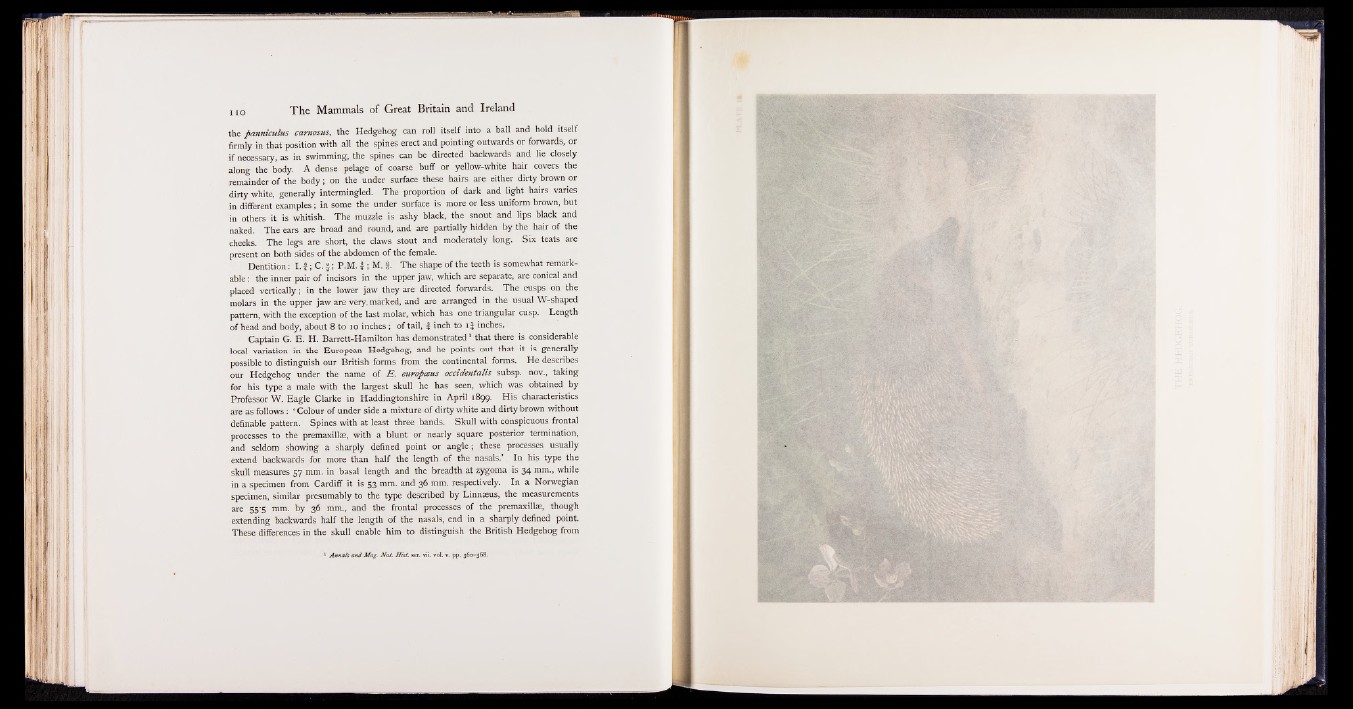
I I O The Mammals of Great Britain and Ireland
the panniculus camosus, the Hedgehog can roll itself into a ball and hold itself
firmly in that position with all the spines erect and pointing outwards or forwards, or
if necessary, as in swimming, the spines can be directed backwards and lie closely
along the body. A dense pelage of coarse buff or yellow-white hair covers the
remainder of the body; on the under surface these hairs are either dirty brown or
dirty white, generally intermingled. The proportion of dark and light hairs varies
in different examples; in some the under surface is more or less uniform brown, but
in others it is whitish. The muzzle is ashy black, the snout and lips black and
naked. The ears are broad and round, and are partially hidden by the hair of the
cheeks. The legs are short, the claws stout and moderately long. Six teats are
present on both sides of the abdomen of the female.
Dentition: I. f ; C. f ; P.M. f ; M. i The shape of the teeth is somewhat remarkable
: the inner pair of incisors in the upper jaw, which are separate, are conical and
placed vertically; in the lower jaw they are directed forwards. The cusps on the
molars in the upper jaw are very, marked, and are arranged in the usual W-shaped
pattern, with the exception of the last molar, which has one triangular cusp. Length
of head and body, about 8 to io inches; of tail, f inch to inches.
Captain G. E. H. Barrett-Hamilton has demonstrated1 that there is considerable
local variation in the European Hedgehog, and he points out that it is generally
possible to distinguish our British forms from the continental forms. He describes
our Hedgehog under the name of E . europceus occidentalis subsp. nov., taking
for his type a male with the largest skull he has seen, which was obtained by
Professor W. Eagle Clarke in Haddingtonshire in April 1899- His characteristics
are as follows: ‘ Colour of under side a mixture of dirty white and dirty brown without
definable pattern. Spines with at least three bands. Skull with conspicuous frontal
processes to the premaxillae, with a blunt or nearly square posterior termination,
and seldom showing a sharply defined point or angle; these processes usually
extend backwards for more than half the length of the nasals.’ In his type the
skull measures 57 mm. in basal length and the breadth at zygoma is 34 mm., while
in a specimen from Cardiff it is 53 mm. and 36 mm. respectively. In a Norwegian
specimen, similar presumably to the type described by Linnaeus, the measurements
are 55-5 mm. by 36 mm., and the frontal processes of the premaxillae, though
extending backwards half the length of the nasals, end in a sharply defined point.
These differences in the skull enable him to distinguish the British Hedgehog from
1 Annals and Mag. Nat. H ist. ser. vii. vol. v. pp. 360-368.